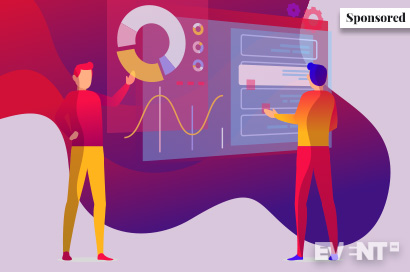This is a sponsored post written by Nishita Jain, Sr. Digital Marketing Director, a2z. More information about Event Manager Blog’s sponsored posts.
B2B event planning is an extremely demanding role. Teams responsible for organizing and managing business tradeshows, exhibitions, conferences, conventions, and meeting require a multitude of skills and techniques to be successful and scale their events.
A decade ago, it was the ability to work with computers and technology platforms that was perceived as a requirement even for non-technical professionals. However, with the ubiquitous acceptance of software UI, UX and learnability principles as well as the availability of well-integrated platforms, putting technology to work is not the key challenge anymore. Organizations across the board are working hard to tap into the value of data to create better, more enhanced experiences for their customers. In all seriousness, they are working to disrupt their own business models before somebody else does.
Data-Driven Decision Making and the Importance for Your Events
To keep pace with the rest of the world, event planners have to add a new, must-have competency in their repertoire – the ability to analyze, comprehend and leverage data.
There are many factors driving this change.
While business events are maintaining their place in the corporate marketing mix amidst significant economic and political uncertainties, exhibitors and sponsors are also looking for increasing returns on their investments. In response to this, organizers of many leading business events have changed their focus from the narrow role of enabling onsite interactions to being a catalyst to establishing long-term business relations.
There is also a sense of urgency to provide personalized and customized experiences to attendees because they are looking to squeeze the maximum benefits from their shrinking budgets and shorter time at any given event.
In essence, gone are the days when event planners could make decisions based purely on intuition or a broad understanding of their audience. Data analyses are rightly perceived as the key decision-making tool and planners who can make short-term and long-term decisions driven by accurate data analysis are the ones who are forging ahead.
The top leadership at both not-for-profit as well as for-profit organizations is now looking for recommendations based on deep contemplation of trends as revealed by multi-year, multi-dimensional scrutiny. Event management executives are required to be perpetually on top of emerging trends and nascent opportunities for their events and audiences. In addition, markets and verticals are becoming very complex than ever before and face-to-face events need to evolve very fast as a response. Show management teams can make even more insightful projections and decisions. Of course, it’s one thing to recognize the importance of data-driven decision making, and another to actually do it successfully.
It’s not easy to manage, correlate and mine data. It takes much introspection and attention to detail to conduct this exercise. However, like most skills, it’s very much a skill that can be learned and perfected. The starting point, of course, in utilizing technology, techniques, and processes that help you collect accurate data in an efficient and accurate manner.
Smart Analyses for Scaling Your Events
Event management teams should focus on analyses that crack key financial and operational problems. To be successful with data analysis, what’s needed is a clear strategy, critical thinking and very well defined objectives. Pose questions that will help you identify hidden stories in your data and help you come up with actionable insights. Focus on insights that can generate commercial value and higher engagement.
Wondering where to start?
Below is a quick list of meaningful questions that you can consider in your data analyses to discover opportunities for future growth and address emerging issues:
Is there a supply-demand gap at my events?
Doing a detailed supply-demand gap assessment can capitalize on unmet demand. For example, evaluate the demand-supply gap for exhibitor product categories using data for online searches, booth views and onsite visits. Compare your exposition offerings with the sessions in demand with the attendees. This will help you identify the newly trending categories for which you may want to get more representation at your next event. By analyzing the supply-demand gaps, you can bring a better focus to your sales and marketing strategies. You can also use the graphs and data to attract prospective exhibitors as well as new attendees to your event. Simply put, the more you know, the better-informed decisions you can make.
Is my attendee retention pacing with the industry?
Numerous case studies have revealed that the cost of acquiring new attendees is much higher than the cost of retaining your existing attendees. In addition to analyzing the retention numbers for your event, we also recommend evaluating the averages and benchmarks within the industry. Proactive retention prevents active defections to your competition and enables your event to build a long-term relationship and credibility with your audience. It also has the potential to help you identify the needs of new attendees, so that you can make a program to align with their goals.
Which booths and sections of the floor plan are generating the most online/onsite traffic?
Map exhibitor leads onto your show floor to identify traffic patterns as well as popular categories, pavilions, zones, and more. Tracking the performance of the most popular companies and booths can help you gather and deliver valuable insights on which segments and tactics are delivering the maximum engagement and share with your sales team.
Are there significant shifts in retention rate, specific categories, and changes in NSF from YOY of your new exhibitors?
It’s useful to gather the percentage of exhibitors retained in the current year, but you must dig deeper to truly understand the behavior of your event(s). Understanding where your new exhibitors are coming from, what categories they represent, and which ones are returning – these are indicators of underlying current industry shifts that can either challenge or help your event grow in the future.
What are the demographics of both suppliers and buyers within their specific geographical locations?
Each location may have separate demographics and categories requiring your sales team to come up with region-specific sales pitches that address the requirements of the targeted audience. Coordinate with your registration partner and your exhibit management partner at the start of the show cycle so that you can easily glean this data before and beyond your event.
IN CONCLUSION
Getting a firm grip on your event data instills a better degree of business confidence and adaptability as event organizers plan for the future. The most common issue today is not the paucity of data but rather figuring out what to do with all the data that is being collected and aggregated for their events.
The knowledge and intelligence gained from comparative analysis of your events’ data will help you stay tuned into your event’s vertical and grow it to new heights, all with the help of those tried and true exhibitors and supporters that have been with you every step of the way. Investing the time and effort required to acquire knowledge and skills for compelling data analysis today will bring significant value to business events in the long term. It’s as much a people-driven process as it is about technology.






